1. Taj Mahal
"A Monumental Ode to Love"
Taj Mahal, Agra Overview
What is widely considered as the most beautiful building in the world, the Taj Mahal is located in the historical city of Agra. It was built by the Mughal Emperor Shah Jahan as a memorial for his third wife, Mumtaz Mahal. Constructed entirely out of white marble in the 17th century, it is among the finest edifices of Mughal architecture. Recognized by UNESCO as a world heritage site, this monument is also considered to be one of the seven wonders of the modern world. Every year visitors numbering more than the entire population of Agra pass through the magnificent gates to catch a glimpse of this breathtaking monument, and only a few leave disappointed. Shah Jahan said about the Taj that it made "the sun and the moon shed tears from their eyes".
The Taj Mahal stands for the Crown of Palaces in the Persian language. It rises from the dust-beaten earth of Uttar Pradesh, but even the wildest imaginations leave visitors underprepared for this world wonder. Covering an area of approximately 42 Acres, the Taj Mahal was constructed using white marble obtained from Makrana in Rajasthan.
Rabindranath Tagore described it as "a teardrop in the cheek of eternity" while Rudyard Kipling said it is "the embodiment of all things pure". The construction of the Taj Mahal began in 1631 and took 17 years before it was completed in 1648! The tomb is laid out in a rectangular shape and can be approached through a massive gateway which has an arch and alcoves on either side of it. The Taj, so majestic from the exterior, has equally splendid artistic work done in the interiors. There are water channels and fountains in the entrance which makes the monument even more spectacular. The reflection of this majestic spectacle in the Yamuna is almost poetic in its perfection!
2. Fatehpur Sikri
"The Pride of the Mughal Empire"
Fatehpur Sikri, Agra Overview
Located at a distance of 40km from Agra, Fatehpur Sikri is a perfect one day trip from Agra. A city predominantly made of red sandstone, Fatehpur Sikri was founded in the 16th century by Mughal Emperor Akbar. It is essentially a fortified city built by the king and had been the capital of his Empire for fifteen years. Now a UNESCO world heritage site and a famous tourist attraction, it is a fine example of Mughal architecture. Fatehpur Sikri is home to Jodha Bai's palace, Jama Mosque, Buland Darwaza, and a Tomb of Salim Chisti among many other famous monuments, each of which, is an integral part of the Indian heritage.
A unique blend of architectural excellence, as well as religious beliefs - sums up Fatehpur Sikri. This monument was built by Akbar to honor Sheikh Salim Chisti, whose prediction of the birth of a Mughal heir came true while Akbar was visiting the then city of Sikri. In honor of the prophecy, Akbar built this city and Jama Masjid, a stunning mosque which is still in use today. He also undertook the construction of three palaces for each of his favorite wives, one a Hindu, one a Muslim and one a Christian. An Indo-Islamic Masterpiece, Fatehpur Sikri is enclosed by an 11 km long fortification wall that has various gateways.
3. Agra Fort
"An Epitome of the Mughal Dynasty"
Agra Fort, Agra Overview
An architectural masterpiece, The Red Fort of Agra or Agra Fort was built by Emperor Akbar in 1573. It is, in fact, a massive fortification located on the right bank of the River Yamuna in Agra, Uttar Pradesh, and is made entirely of red sandstone. The fort was once the erstwhile residence of the Mughals until the year 1638. One of the UNESCO World Heritage Sites and lies at a distance of 2.5 kilometers from another wonder of the modern world - The Famous Taj Mahal. The area of Agra Fort is so massive that it is often referred to as a walled city. Made from red sandstone brought to Agra all the way from Rajasthan, this imposing structure is as majestic as it is beautiful and delicate.
Agra Fort is one of the most special monuments built by the Mughals and has richly decorated buildings. It is the perfect example of the Mughal style of art and architecture and is one of the most visited tourist spots in Agra. Built purely out of red sandstone, this expansive architecture stands out against the soft azure of the sky. Within the premises of the fort lie the most exquisite structures of the Mughals like the Pearl Mosque, Diwan-i I Khas, Diwan-i I Aam, Moti Masjid, and Jahangiri Mahal. Each and every one of these edifices have remarkable handiwork and ornamentation that make this place a delight for every history and architecture lover. You can also get a splendid view of the Taj Mahal from the Agra Fort!
4. Itimad-ud-daulah's Tomb
Tomb of Itimad-ud-Daulah, Agra Overview
Often referred to as the "Baby Taj Mahal", the tomb of Itimad-ud-daulah is a Mughal mausoleum and often regarded as a copy of the Taj Mahal. This is the first tomb in India made entirely of marble. It is the tomb of Mir Gheyas Beg (later known as Itimad-ud-daulah), who was a minister in the court of Shah Jahan. Visiting Itimad-ud-daulah's Tomb is like taking a step back in time into Agra's history.
The tomb of Itimad-ud-daulah marks the transition from the first phase of the Mughal architecture to the second. This was the first structure to make use of pietra dura and the first to be built on the banks of the Yamuna River. It basically consists of Indo-Islamic architecture, with the use of arched entrances and octagonal shaped towers. If you take a bird's eye of Itimad-ud-daulah Tomb, it looks like a jewel box set in a garden. This magnificent mausoleum, built on the banks of Yamuna, was to inspire the construction of one of the wonders of the world "Taj Mahal" in the later years.
5.Mehtab Bagh
Mehtab Bagh, Agra Overview
Located just north to the glorious wonder called the Taj Mahal and overlooking the Agra Fort and Yamuna river on the opposite side, Mehtab Bagh is one of the last Mughal gardens and one of the most scenic spots in Agra. Perfectly quadrilateral in shape and colloquially known as the Moonlight Garden, the stunning Mehtab Bagh is the last one of the eleven similar Mughal- built garden complexes along the Yamuna bank. Laid out in just the right symmetry and perfectly aligned with the gardens of the Taj Mahal, the garden provides a picture-perfect view of the Taj from the fountain at the front of the entrance gate. Mehtab Bagh is a popular sunset spot among the photography fanatics and nature enthusiasts.
The splendid Mehtab Bagh has four sandstone towers, one each at the corner with a huge octagonal tank right in the center. It is believed that Shah Jahan especially got the bagh designed for his personal interests so he could come up here and admire the infinite beauty of his favorite piece of art. On the moonlit nights, the clear reflection of the wondrous Taj Mahal in the waters of the park is a sight beyond description. Mehtabh Bagh is now a horticulture delight with scores of vibrantly blooming floral plants and medicinal herbs, besides the umpteen fruit trees, which add to the beauty of the park.
6. Taj Mahotsav
Taj Mahotsav, Agra Overview
Taj Mahotsav is an annual ten-day festival that takes place in Agra. The festival showcases an outstanding variety of art and craft, dance, and cuisines of artisans from different regions of India. Kicked off in 1992, this festival provides the platform to the artisans from various states to display their exquisite works of art at the same time also making them available to the tourists at the most reasonable prices. Apart from that, the festival is also a paradise for, food aficionados with a supply of a plethora of varieties of cuisines, children with a Fun Fair in place, and the appreciators of folk culture.
Taj Mahotsav 2020 Dates
2020 Taj Mahotsav will begin on Tuesday, 18 February and ends on Thursday, 27 FebruaryTaj Mahotsav - Venue
Shilpgram district, Agra, IndiaTaj Mahotsav Theme of 2020
DharoharTaj Mahotsav - Ticket Price
- Adult: INR 50 per person-Children up to five years of age: No entry fee
-Children from 5-10 years of age: INR 10 per person
-A group of 100 Schoolchildren: Rs. 500/-
(Entry is free for two teachers with the School Group)
-Foreign Tourist: No entry fee
About Taj Mahotsav Festival
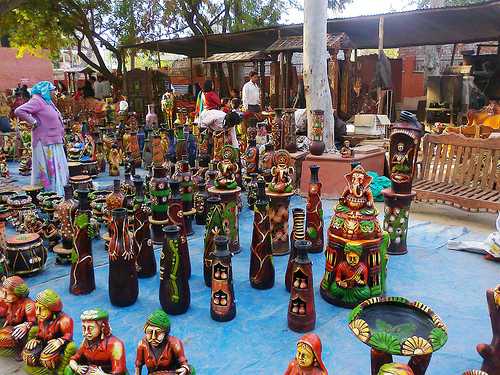
Celebrated every year since 1992, the festival reflects upon the vibrance of art, craft, dance, music, and cuisines of India. One can witness the flamboyance of Indian artisans, through their magnificent works, which can be bought at the most reasonable and authentic prices. The carnival adopts a theme every year to accentuate the rich culture and heritage of India. The theme for 2019 is 'Dharohar', which aims to celebrate India's grandeur of historical monuments.
Taj Mahotsav is organized by the Tourism Ministry of Uttar Pradesh near the Eastern Gate of the marvelous monument, Taj Mahal. Besides being a source to mount tourism in India, the festival is one of the most eagerly awaited. It is organized every year from 18th- 27th of February and this year's celebration will mark the festival's 28th anniversary.
Taj Mahotsav is organized by the Tourism Ministry of Uttar Pradesh near the Eastern Gate of the marvelous monument, Taj Mahal. Besides being a source to mount tourism in India, the festival is one of the most eagerly awaited. It is organized every year from 18th- 27th of February and this year's celebration will mark the festival's 28th anniversary.
Features Of Taj Mahotsav - Programs & Events
Taj Mahotsav celebrates the incredible work of Indian artisans and thus, is a repository of extensive art, enthralling artworks, mouth-watering cuisines, and foot-tapping dance and music. A perfect place for shopaholics, one can fill their bags with an array of things like elegant jewelry, traditional folk dresses, mind-blowing paintings and showpieces, lamps, and exotic furniture, to name a few.The Fiesta provides an ultimate platform for artisans from various regions to display their meticulous craftsmanship. Around 400 people from different areas in India get an opportunity to present their vibrant work. The annual festival commences with a road procession of splendidly decorated camels and elephants, emulating the victory procession of Mughal emperors and Warlords of the bygone era.
Art and Craft
- Wood carvings from Saharanpur,
- Pottery from Khurja
- Zardozi and marble work from Agra,
- Chikan work from Lucknow.
- Brass and metal wares from Moradabad,
- Handmade carpets from Kashmir and Gujarat,
- Silk and zari work from Benaras and
It also has a spectacular collection of hand-printed material from Farrukhabad and Bengal's well known Kantha stitch. The Crafts Mela is one of the major attractions of Taj Mahotsav rekindling the majesty of the Mughal empire.
Dance And Music
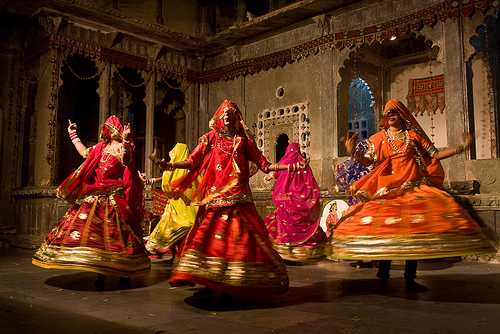
Cuisines
Taj Mahotsav takes delight in offering a lip-smacking variety of delicacies and hence is an excellent spot for foodies. With a plethora of delicious dishes to choose from, the place will pamper one's taste buds. The food festival also has a rich variety of food prepared from within the interiors of Uttar Pradesh that one can relish. One gets a chance to taste the most exotic cuisines from different parts of India while also enjoying the mesmerizing aroma of the appetites being cooked.Fun Fair
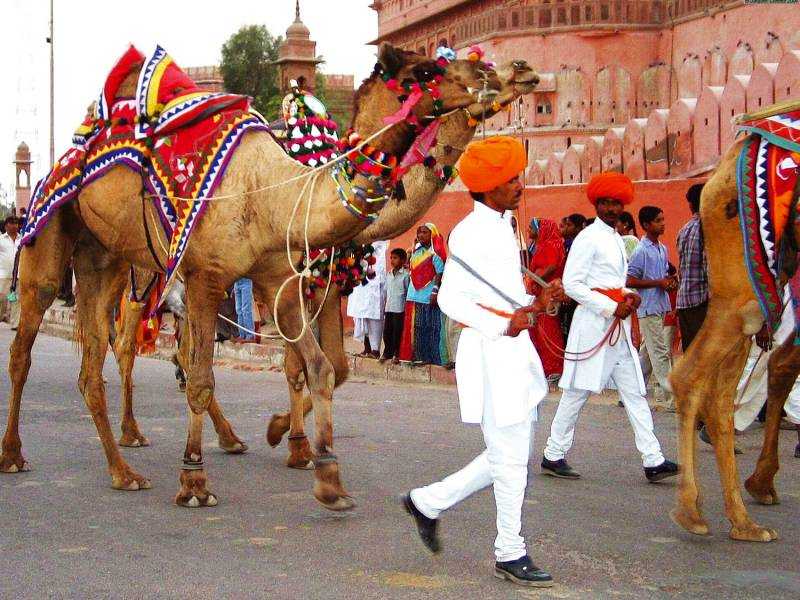
Taj Mahotsav is a festival that charms both adults and children alike. Children can delight themselves by various fun-filled rides like train rides, elephant and camel rides, roller coaster and Ferris wheel. The Mahotsav is profuse with thrill and amusement, thus making it a complete family entertainer.
Why Visit Taj Mahotsav?
How To Reach Here?
One can reach here by any vehicle of their choice. The road connectivity to this area is very efficient. The nearest railway station to Taj Mahotsav is Agra Cantt. The place is also within 13 km to Kheria airport, with many commercial flights connecting Delhi to Agra.
Thus, The Taj Mahotsav is a cultural extravaganza that is celebrated with a lot of enthusiasm. The lavish festival with all its pomp and show will render one a reminiscing experience.
7) Ram Barat
Ram Barat, Agra Overview
The Ram Barat is a joyous and one of the most important festivals in Northern India held in September every year. Marked by a footfall of over 20 lakh people every year, this festival celebrates the divine marriage ceremony of Lord Rama by taking out his marriage procession and carrying out all the ceremonies related to marriage. Janakpuri, the bride's place, is elaborately decorated with lights and flowers for the royal wedding to welcome the procession. The entirety of the Ram Barat is a riot of religious processions, colors, lights, and merry laughter at every corner.
Ram Barat 2020 - Date
The Ram Barat is held amidst the Ramleela Celebrations between 17th September to 22nd September in 2020The venue of Ram Barat
The venue for the Ram Barat is different every year. This venue is chosen from the many neighborhoods in Agra.Celebrations at Ram Barat - Events & Festivities
The Ram Barat is held at just about the end of the Navratri season and before the start of Dussehra. The Ram Barat is made doubly special with the three-day procession that is the center of attraction during the festival. This procession is meant to be a symbol of the wedding procession that took the bride-groom all the way to the Janak Mahal.The parade passes different neighborhoods every year, and each of these neighborhoods takes out their most extravagant decorations and put them up in with all splendor every single year. The chariots or "raths" are the center of attention during the 8-kilometer long procession, along with the many individuals who are dressed up as different characters from the myth. Several bands also accompany the people joining the parade and heighten the merry atmosphere to that of trance-like happiness.
Day 1 of Ram Barat
On the first day of the Ram Barat, all individuals gather at the starting point from where the festivities are deemed to have begun. It is the start of the three-day-long procession that is, in all its glory, the Ram Barat. The cinema halls also run a live telecast far into the night instead of the locals wishing to catch a glimpse of the festivities. From here on, all events that are typical of a great Indian wedding can be seen carried out by the locals who participate in the Ram Barat.Day 2 of Ram Barat
On the second day of the Ram Barat, the procession is said to pass the Agra Fort which is meant to be significant to the kingdom of King Janak, the father of Sita. On this day, the procession moves through many neighborhoods, allowing the locals to witness the Barat and all its grandeur. All these neighborhoods are decorated with colorful flowers, lights, and all other decorations under the sun.Day 3 of Ram Barat
The third day of the Ram Barat marks the final day of the long carnival-like scene you will witness in Agra. The day is also significant as the procession reaches its destination and all locals are dressed in their finest livery for the wedding and "vidai" or going away of the bride that takes place.History of Ram Barat
As stated in recordings, the Ram Bharat has been celebrated for over one hundred and thirty years. This makes the festival as good as an annual tradition for the individuals living in the north of India. The Ram Bharat festivities were first initiated by Lala Kokamal and had since then been managed by the generations of the very family. Each year, the celebrations have been growing in number and are a source of pride as well as that of expressing sincere devotion to the religion and the myths of the Ramayana.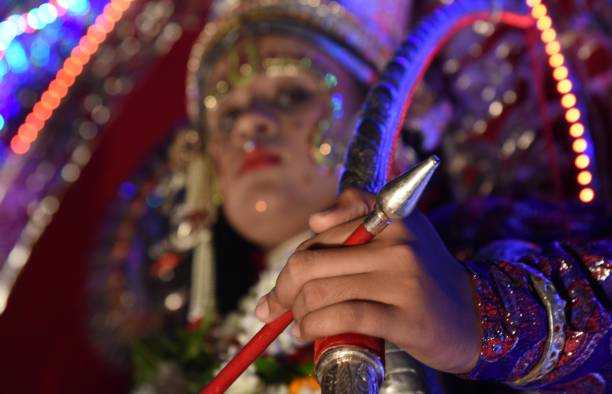
The Ram Barat is a time of happiness and celebration for entire North India. The Barat plays a significant part in strengthening people's beliefs and increases their bonds to Indian Culture. The festival is one that is enjoyed by all, spectator and participators, and one that cannot be missed by any who is present in the vicinity during these months.
8) Mother Teresa's Missionaries Of Charity
Mother Teresa's Missionaries Of Charity, Agra Overview
"There are no great things, only small things with great love" - Mother Teresa
Mother Teresa is a woman beyond description, beyond words, and beyond the introduction. An Albanian by birth, she had been brought up by a single mother. On a yearly trip to the chapel of the Madonna of Lettice, she knew what her calling in life was, and that's when she decided she wanted nothing from the world but to provide peace and solace to those who were suffering. She moved to India in 1929; by 1931 she had taken her vows, and by the end of 1950, she had set up her first Missionaries of Charity. It was an honest effort to serve ? the hungry, the homeless, the naked, the crippled, the blind, the lepers, all those people who feel unwanted, unloved, uncared? and basically anyone and everyone who was in need of comfort or care.
Mother Teresa is a woman beyond description, beyond words, and beyond the introduction. An Albanian by birth, she had been brought up by a single mother. On a yearly trip to the chapel of the Madonna of Lettice, she knew what her calling in life was, and that's when she decided she wanted nothing from the world but to provide peace and solace to those who were suffering. She moved to India in 1929; by 1931 she had taken her vows, and by the end of 1950, she had set up her first Missionaries of Charity. It was an honest effort to serve ? the hungry, the homeless, the naked, the crippled, the blind, the lepers, all those people who feel unwanted, unloved, uncared? and basically anyone and everyone who was in need of comfort or care.
At the time of her death in 1997, the Missionaries of Charity was operating in 123 countries on over 610 missions which included providing hospices to the homeless/ the ones diagnosed with AIDS/HIV or leprosy, in addition to operating several orphanages and schools and charity homes for the orphans and the elderly. One of these charity homes is based in Agra and goes by its staple name- Mother Teresa's Missionaries of Charity. It works for the upbringing, well- being and education of the orphaned kids in addition to caring for the elderly and the homeless.
We recommend you to stop by at the Missionaries center for an hour or so, to pay respect to the commendable effort taken up by Mother Teresa and the? mothers? who selflessly follow her. Spend some time with the unprivileged, share some smiles, and realize your many privileges. Take a tour of the premises and observe the unconditional love and nurturing that the nuns share with the kids and the elderly. If possible, leave a small donation and help make a huge difference for the good work to continue. If nothing, we promise you peace and extreme thankfulness, on your return.
Taj Museum, Agra Overview
Located inside the Taj Mahal complex, the Taj Museum was established in 1982 on the western ends of the Taj Gardens. The tiny but terrific depository is a double-storeyed building with a quadrangle projection outside. Situated a little left on the main gate of the mausoleum inside the Jal Mahal, the museum provides the wonderful opportunity to have a close look at the blueprints, arts, and artifacts used in the construction of the world-class monument. It also houses paintings displaying the construction and planning of the graves of the Emperor and his Emperess and the angles measured are so, that the foot of the graves always faces the spectators.
As the name suggests, the museum is all about telling the tale of the Taj. It is a popular place of visit among the travelers as it is home to the facts and history relating to the magnificent monument. You can also find gold and silver coins minted in Agra at the time. We recommend you to visit the place if you are in for a little historical and factual retreat.
Anguri Bagh, Agra Overview
Centrally situated in the premises of Khas Mahal, Anguri Bagh was built by Mughal Emperor Shah Jahan in 1637. As the name suggests, Khas Mahal (or Aramgah- i - Muqaddasa) was constructed for the emperor as his exalted place of leisure and rest, to suit his taste. Besides the several other additions in the palace, the main part consists of a hall with recess and rooms in a surrounding semicircular pattern and a huge courtyard in the front with tanks, fountains, and hammams overlooking a spectacular garden which is- Anguri Bagh. The hammams or the imperial baths were used by the royal women to spend time in complete privacy, to relax and to socialize, and the paradise garden right in front was designed as the idea for their pleasant retreat.
This sprawling charbagh (four complex compartments) styled garden is flecked with intricate geometrical patterns. Originally popular for thick creepers of grapes- their cultivation and harvesting, the garden accurately came to be called the Garden of Grapes (Anguri Bagh). The surrounding structure is composed of fine white marble which was initially painted and gilded in gold and was adorned with exquisite beautiful paintings. It is believed that back in olden times the garden had lush green vineyards of choicest and juiciest grapes, and was prettified with beautiful water fountains and small artificial cascades. If touring Agra Fort, this is a must-visit spot for an insightful exploration of the Mughal history.
Chini ka Rauza, Agra Overview
Dedicated to the memory of the Prime Minister of the court Allama Afzal Khan Mullah, during the reign of the Mughal Emperor Shah Jahan, Chini ka Rauza is a funerary monument situated on the eastern bank of the Yamuna river in Agra. Also known as China Tomb, ‘Chini’ meaning ‘from China’ and ‘Rauza’ meaning ‘tomb’, the shrine is the final resting place of the Persian scholar and poet. Built between 1628 and 1639, the architecture of Chini ka Rauza is a marvelous fusion of the Indo-Persian style.
The monument located 1 km north of Itimad-up-daulah's Tomb, is hidden away in an alcove of trees and is usually an unusual but a happy discovery among tourists. It is supposedly the first of its kind to be decorated by glazed tile work. The tiles are known to have been imported from China which makes the monument even more striking with their color embellishments and artwork. Although the enamels and inlay work is wearing off due to climatic conditions and absence of renovation, the Chini ka Rauza is a fantastic example of long-gone style and architecture.
"The Holy Heart of Agra"
Jama Masjid, Agra Overview
Jama Masjid at Agra also known as 'Friday Mosque' is a seventeenth-century structure and is one of the largest mosques built by the Mughals in India. Constructed under the reign of Shah Jahan in 1648, Jama Masjid is dedicated to his favorite daughter Jahan Ara Begum. This splendid monument is visible from the Agra Fort with the Agra Fort Railway station right between the two structures. Jama Masjid has huge significance in Indian history and culture and has been intricately designed with multi-colored marbles and sandstone.
The Jama Masjid is built mainly of red sandstone and white marble that stand as a testimony to the magnificent Mughal architecture. The design of Jama Masjid is unique. It has a fountain at the center and is supported by four kiosks in the courtyard. The interior walls have scriptures in the Persian style praising for Shah Jahan and Jahan Ara. The inlaid panels of work here are quite similar to that of the Taj Mahal and are common to all the monuments and structures built by the Mughals in Agra. Every Friday, special prayers are conducted at this mosque which is attended by thousands of devotees. The Tomb of Salim Chisti is a part of the mosque compound.
Tomb of Akbar, Agra Overview
The final resting place of the great Mughal Emperor, Akbar, Tomb of Akbar is an important architectural masterpiece of the Mughal era. Located in Sikandra, a suburb of Agra, the tomb is believed to have been built between 1605 and 1618. Although the tomb is the place where one of the greatest emperors of India is buried, the Mughal gardens around it present a beautiful and cheerful facade. Built entirely out of sandstone and white marble, Emperor Akbar himself oversaw the construction of this tomb until his death. However, the construction of Akbar's Tomb was completed by his son Salim. Unlike the other tombs of famous Muslim kings around the world, the Tomb of Akbar faces towards the rising sun instead of Masjid of Mecca
The tomb is situated in Sikandra, the outskirts of Agra, and spreads over an area of 119 acres. The main tomb is surrounded by a beautiful garden that was designed by Akbar himself. His wife's (Mariam-uz-Zamani Begam) tomb is also located in Sikandra about a kilometer away from Akbar's Tomb. The main structure of the tomb is built out of sandstone and a portion is made from marble. Following Tartary traditions, that state that one must see-through the construction of one's tomb themselves, Akbar lived through the construction of his tomb and built a beautiful garden around it.
Agra is primarily known for its monuments, forts, palaces, and mausoleums, but, hidden behind these architectural wonders are the traditional shopping centers and bazaars. Agra is one of the most visited cities in India being the fourth largest city in Uttar Pradesh. One can find numerous varieties of unique and extinct crafts that are nowhere to be seen these days. One of the most commonly bought collectibles is called 'Bric-a-Brac' which is a small marble replica of the Taj Mahal. A person coming to Agra is not likely to go back empty-handed for there are so many shops of art, craft, and other souvenirs. The distinguishing feature of the markets of Agra is that every store here is unique in its way and known for a different product altogether. In addition to these street shops, there are some very well established malls having all the brands. The Taj Mahal and other famous monuments of Agra become a lot more happening during the time of festivities with all the local handicrafts and arts put on display. The food here is mouth-watering especially Petha, Dalmoth, and Gajak. It is home to some of the most exquisite handicraft and artifacts markets. The shopping scene in Agra is buzzing with markets, department stores, retail outlets, and local bazaars. Agra is home to many people like the artisans, jewelers, embroiders, carpet makers, and weavers who come here to showcase their precious talent. Agra is one of the largest markets for embroidery and textiles. Most of the major shopping complexes are situated near the Taj Mahal, the most famous ones being Sadar Bazaar, Kinari Bazaar, and Munro Road.
Let us now have a look at some of the most 8 famous streets for Shopping in Agra and their specialties.
1. Sadar Bazaar
Sadar Bazaar is one of the most famous shopping spots of Agra situated near the Agra Cantt railway station. Everything ranging from handicrafts, sweets, garments to leather bags can be found at a single place. Cafes such as Café Coffee Day too are situated near the market in addition to some delicious vegetarian as well as non-vegetarian food joints.
Best Known For
Since Agra is very famous for its leather products, do not forget to buy them from here. A store named Taj Leather World located in the market is reasonable and offers good quality products. If you want to buy ethnic clothing, footwear, and accessories, you need to head out to the Sadar Bazaar!
Tips
Always bargain before making the final call.
Timings
11:30 AM to 6 PM, Tuesday closed
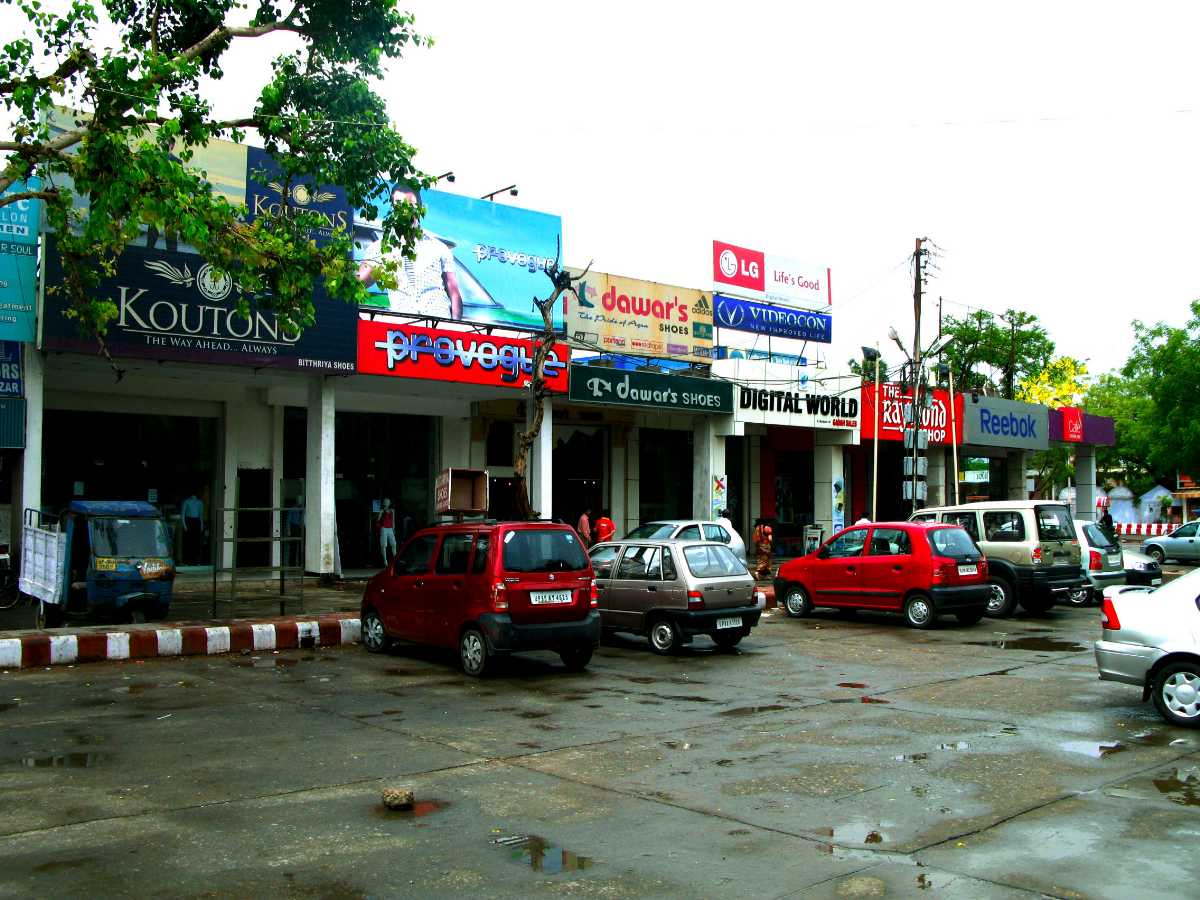
2. Subhash Bazaar
Subhash Bazaar is another popular market of Agra which is situated in Halwai Gali near the northern edge of Jama Masjid nearby the Agra Fort.
Best Known For
One is likely to find a wide variety of products out of which silk products and silk saris are the most famous ones.
Tips
With the right negotiating skills, one is likely to find some good quality products at a reasonable price.
Timings11 AM to 9 PM, Tuesday closed
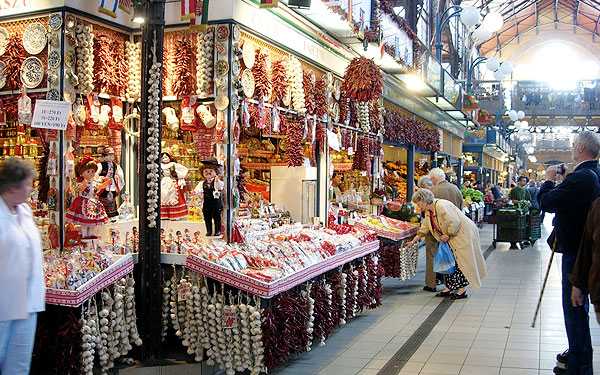
3. Kinari Bazaar
Kinari Bazaar is located near Jama Masjid of Agra. It is the wholesale market of the city with a great history.
Best Known For
This market is famous for its business with wholesalers and retailers. The Kinari Bazaar is home to a wide choice of handicrafts, along with marble, glassware, rugs, leather, and textiles.
Tips
Try to get yourself a good bargain in the wholesale and get good quality products at a reasonable price.
Timings
11 AM to 9 PM, Tuesday closed
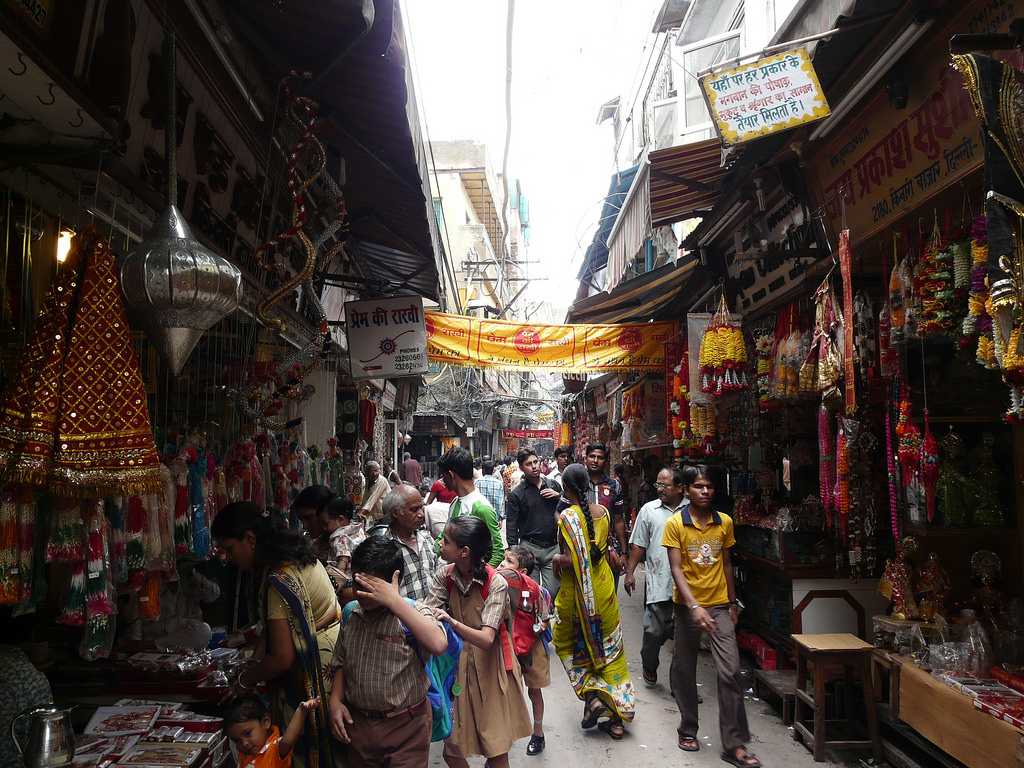
4. TDI Mall
This mall is situated on the Fatehabad Road near the popular Taj Mahal. Apart from being a great shopping spot, the mall is also quite feasible for its entertainment as well as leisure purpose. There is a huge food court too with all kinds of varieties of food dishes. Well-known domestic, as well as international brands, can be found in the mall. A person who adores brands can find a good catch in the mall.
Best Known For
The place is famous for its wide range of products and clothes both branded as well as non-branded.
Tips
Visit the mall when there is a sale on brands because that is the time when you are likely to find a value for money.
Timings
10 AM to 10 PM
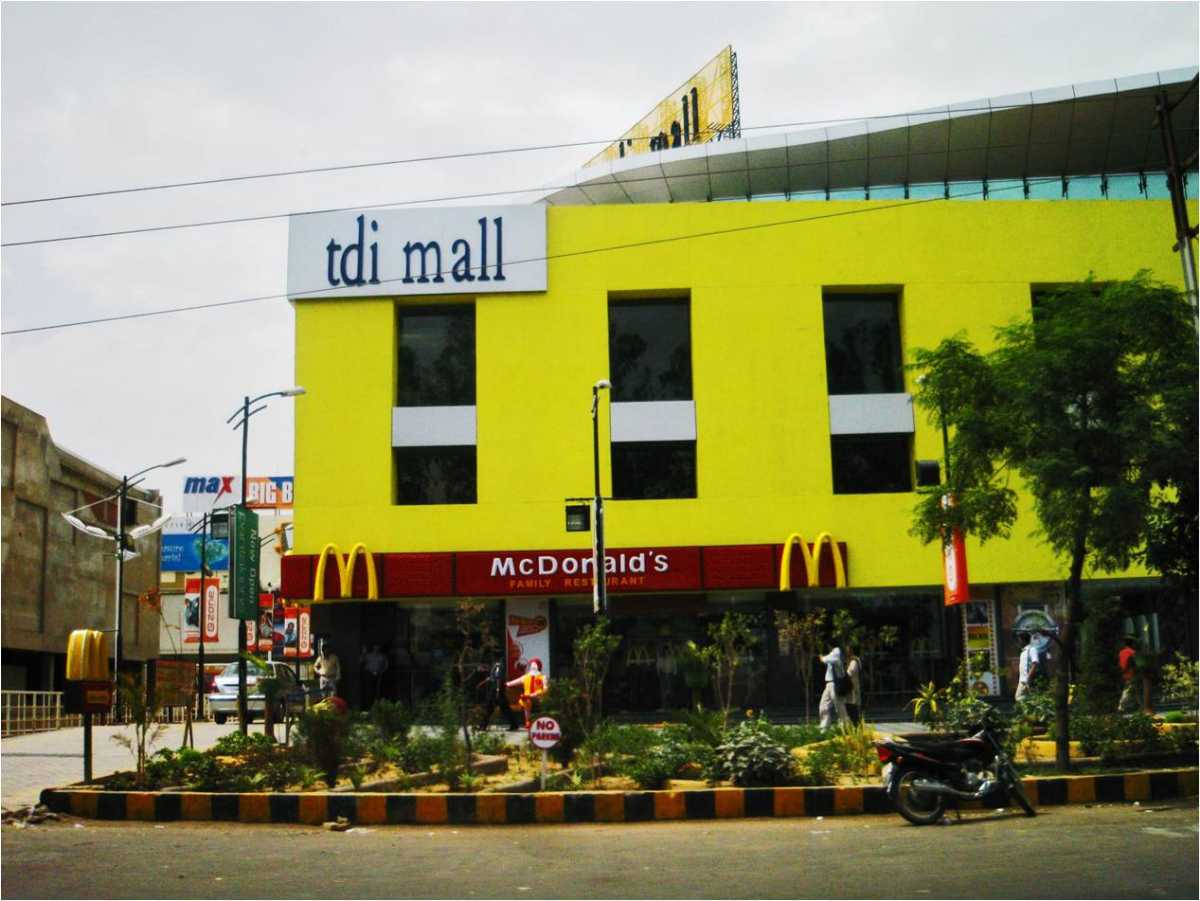
5. Raja Ki Mandi
It is one of the busiest and most crowded shopping markets in the city. A railway station named Raja ki Mandi railway station too is situated right beside the market. This market is located in the Lohamandi region of Agra. It is also one of the most popular marketplaces of Agra.
Best Known For
This market in Agra has some shops including those of garments, sweets, jewelry, ladies' items, household items, and religious items and the list can go on and on. Such is the diverse nature of the market in terms of products offered.
Tips
A person who loves street shopping will adore the place. Also, do not forget to bargain the prices for a reasonable deal.
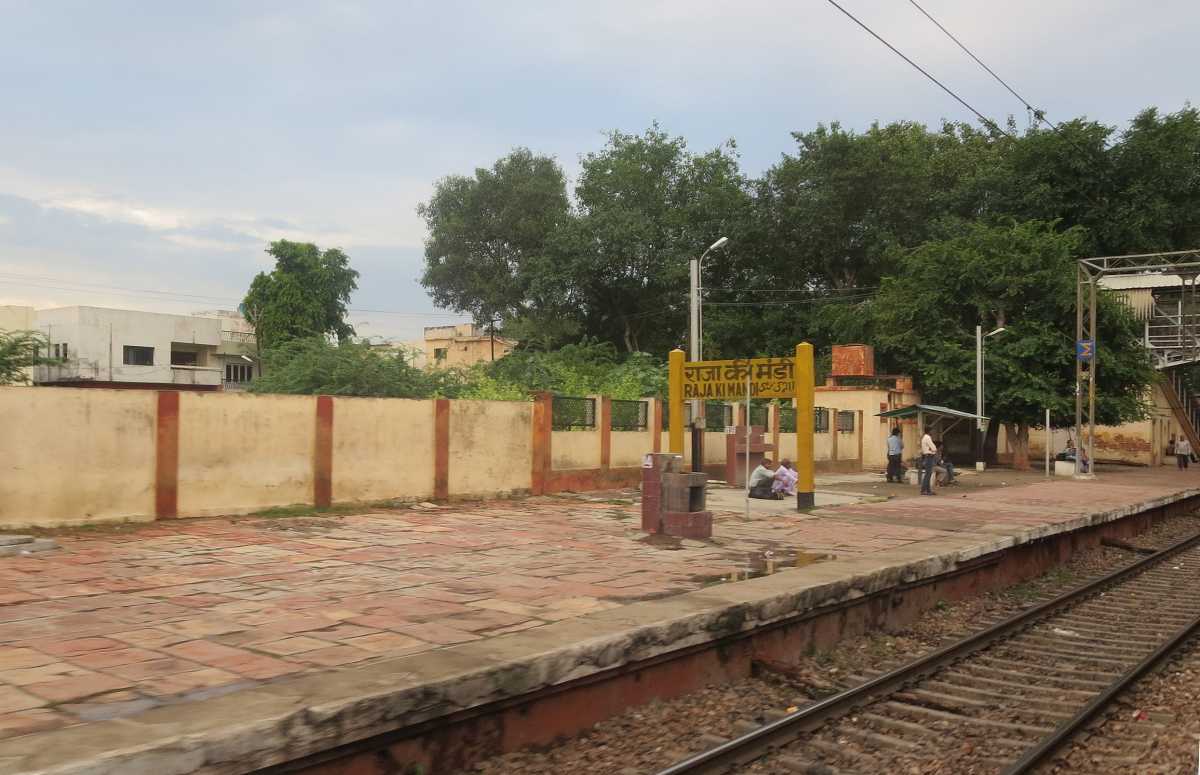
6. Shah Market
This market is situated near the Sanjay Place market of Agra. It is one of the finest wholesale and retail markets in the city.
Best Known For
Smartphones, as well as other branded mobile phones, are present in the market too. If a second-hand mobile phone is needed or the existing one needs some help, this is the perfect place.
Timings
11 AM to 11 PM
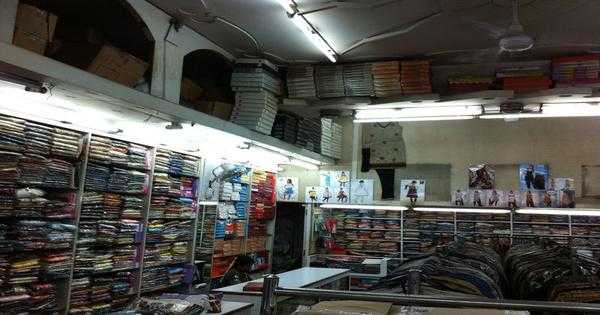
7. Shahganj Bazaar
This local market situated in Agra has grown over the years giving out some good quality products.
Best Known For
Almost everything can be found out in the market from furniture to clothes and ladies' bags to shoes. It also has one of the best vegetable markets in the city. It offers a good and reasonable deal with good quality products.
Tips
Do not give any price quoted. Bargain to some extent. Also, take care of your belongings.

8. Shoe Market
This market is located in an area called Hing Ki Mandi. It is a very famous shoe market in the city.
Best Known For
Since Agra is popular for its footwear industry, one can get a good pair of shoes at the market. One is likely to get a pair of shoes at a reasonable price having good quality.
Tips
Since the market is situated in a congested area, it is advisable not to drive your vehicle there. Instead, use public transport. The market is visited by wholesalers to buy the products in wholesale meaning that one can get quite a good deal at the market.
Timings
10 AM to 4 PM
10 AM to 4 PM
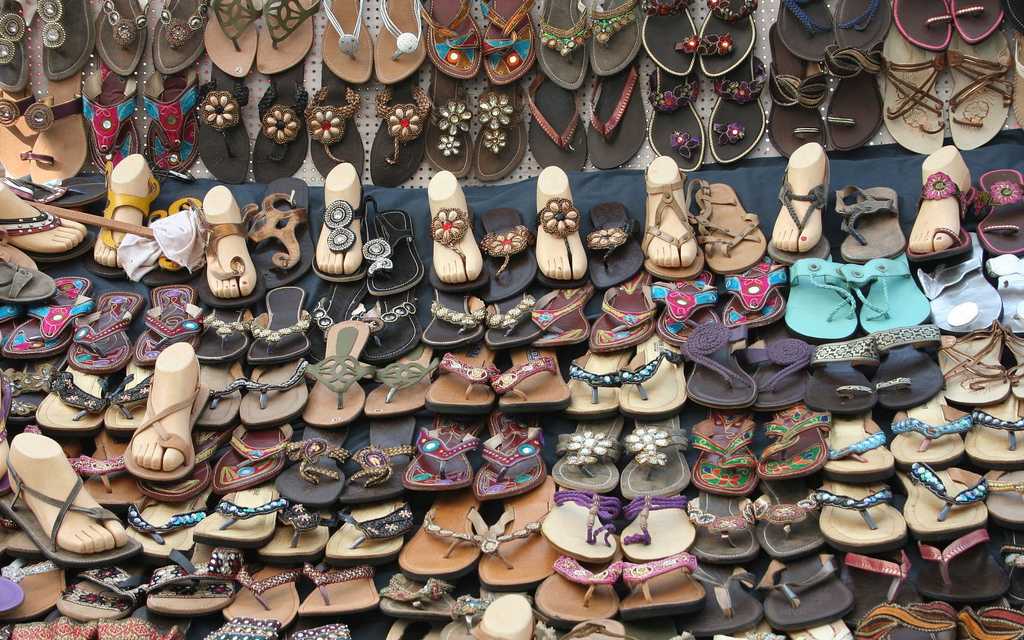
Retail Shopping Outlets in Agra
Numerous retail outlets in Agra have a host of handicrafts on sale. If you want to purchase souvenirs, you can head to the UP Handlooms and UPICA on MG Road. Apart from these, Subhash Emporium offers products made of Agra marble. There are also many big showrooms and government-run handicraft shops that you can shop in.
Things to Buy in Agra
When shopping in Agra, you just can't miss splurging on the marble crafts. You can buy miniature marble replica of the Taj Mahal or the exquisite marble vases, ashtrays, and ornamental boxes. The other thing Agra is famous for is leather, be it leather boots, belts, bags, slippers or jackets. Agra has markets where you can get some of the best deals on leather goods. Another must-buy item is the rugs and carpets. You can choose from a wide range of mats, rugs, wall hangings, and carpets. You can buy carpets for any possible design.
General Tips For Shopping In Agra
While shopping in Agra, be careful about the quality of stone and marble products. One way of identifying is that the genuine marble is opaque and does not allow light to pass through.
Avoid going shopping with drivers or guides at they tend to get heavy commissions, making your items costly
Credit cards are accepted at almost all the shops
The city is beautiful and offers an amazing shopping experience. Do plan a trip to this beautiful place, away from the bustling sound of the city. Places like Agra are a must-visit and a must add-on to the list of the travelers. Apart from offering exquisite items, these bazaars are also reasonable providing umpteen opportunity to practice your bargaining skills. If shopping is on your mind, then Agra won't leave you disappointed!













